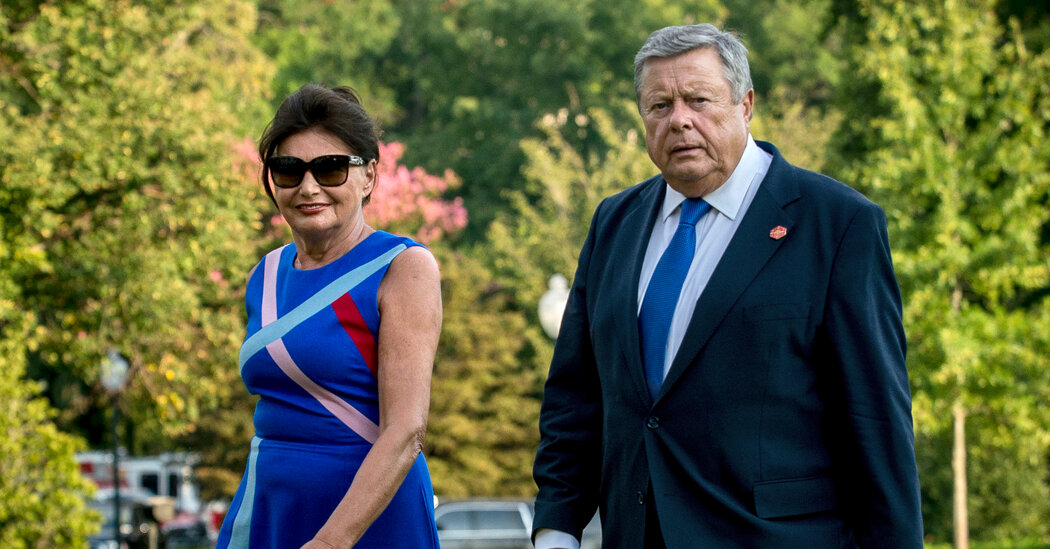Throughout the Trump presidency, Amalija Knavs — mother to first lady Melania Trump — was something of a mysterious figure. Mrs. Knavs, who died earlier this week, rarely made public comments or gave interviews. Striking and perfectly coifed, Mrs. Knavs was a recurring but almost entirely silent presence during the Trump presidency, much like her daughter.
Mrs. Knavs and her husband Victor appeared often in the background of photos of the first family, accompanying them on trips to places like Camp David or Mar-a-Lago, and attending special events. And there’s something startling, even uncanny about photos containing both the Trumps and the Knavses: The two couples look like mirror images of each other. Mr. Trump and Mr. Knavs, just two years apart in age, have similar physiques and stature — even hair styles.
As for the women, Mrs. Trump seems to have inherited Mrs. Knavs’s high cheekbones, slightly square jaw, wide-set almond-shaped eyes, dark hair and photogenic smile. But that’s just genetics. More striking is the similarity of their styles. As numerous photos demonstrate, the two women tended to dress alike — in fitted sheaths or belted dresses, solid color pantsuits, stilettoes and shades. The look is sophisticated and elegant, if also somewhat constricting and self-contained.
But while a garment worker may know a great deal about design and style, the fact that her fashion experience was partially acquired through factory labor was all but dropped from Mrs. Knavs’s narrative during her lifetime. This is a shame, since many Americans might have loved to know her personal story, especially given how closely it resembles a classic American rags-to-riches tale.
As a present-but-absent character, Mrs. Knavs occupied a curious media role for any presidential relative, but especially for a mother. The United States tends to drape its mothers, especially those of senior years, in a mantle of virtue and selflessness — and that is rarely a fitted, luxury outfit. And the mothers of presidents and their spouses enjoy particularly tender — if somewhat gender-stereotypical — treatment, lionized often for the moral lessons they are presumed to have imparted to their children.
President Joe Biden often praises the life lessons he learned from his mother, Jean Finnegan Biden (who died in 2010): “My mom taught her children that you’re defined by your sense of honor,” he said in a 2008 speech. And Michelle Obama’s mother, Marian Shields Robinson (who lived in the White House for several years helping raise her granddaughters), was affectionately called “grandma-in-chief” by the media, and featured in many stories about her shopping trips to everyday places like CVS and Filene’s Basement, her humble beginnings on Chicago’s South Side and the values she imbued in her children.
We heard very little of that sort of talk about Amalija Knavs. And yet, it seems she played a significant role in the first family’s life, and was especially devoted to her grandson, Barron. What explains the disjunction between the remote figure in the photos and the loving grandmother who once harvested onions? Was it just the Trump family attempt at privacy? Or was it too hard for the media to make sense of a grandmother who seemed to prefer Manolos to fuzzy slippers? And then there is the added complexity of the Trump family tree — the Knavses are not related to the three eldest, most famous Trump children, which may have somewhat reduced their need to slot into typical expressions of “grandparents.”
Now, with her passing, we are learning more about Mrs. Knavs, and can connect the dots from her hardscrabble beginnings in a former Soviet bloc country to her recent life in Palm Beach. Acknowledging Mrs. Knavs’s origins during her lifetime might have gone a long way toward softening Mrs. Trump’s image during her time as first lady. Instead, Mrs. Knavs was presented to us as a near clone of her daughter, a retinal after-image of Mrs. Trump’s own inscrutable glamour.







